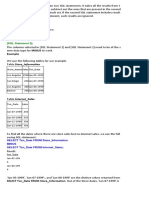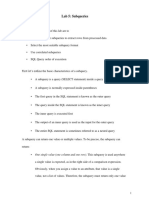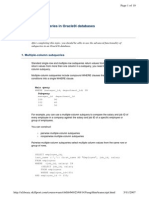MySQL Subquery
Uploaded by
Rajesh KumarMySQL Subquery
Uploaded by
Rajesh KumarMySQL Subquery
A subquery in MySQL is a query, which is nested into another SQL query and
embedded with SELECT, INSERT, UPDATE or DELETE statement along with the various
operators. We can also nest the subquery with another subquery.
A subquery is known as the inner query, and the query that contains subquery is
known as the outer query.
The inner query executed first gives the result to the outer query, and then the
main/outer query will be performed.
You can use a query like
SELECT category_name FROM categories WHERE category_id =( SELECT MIN(category_id) from movies);
It gives a result
Let’s see how this query works
The above is a form of Row Sub-Query. In such sub-queries the , inner query
can give only ONE result. The permissible operators when work with row
subqueries are [=, >, =, <=, ,!=, ]
The following are the rules to use subqueries:
o Subqueries should always use in parentheses.
o If the main query does not have multiple columns for subquery, then a
subquery can have only one column in the SELECT command.
o We can use various comparison operators with the subquery, such as >, <, =,
IN, ANY, SOME, and ALL. A multiple-row operator is very useful when the
subquery returns more than one row.
o We cannot use the ORDER BY clause in a subquery, although it can be used
inside the main query.
o If we use a subquery in a set function, it cannot be immediately enclosed in a
set function.
The following are the advantages of using subqueries:
o The subqueries make the queries in a structured form that allows us to isolate
each part of a statement.
o The subqueries provide alternative ways to query the data from the table;
otherwise, we need to use complex joins and unions.
o The subqueries are more readable than complex join or union statements.
You might also like
- MySQL JOINS Are Used With SELECT StatementNo ratings yetMySQL JOINS Are Used With SELECT Statement7 pages
- SUBQuereis - Corelated Queries - IN - ANY - ALLNo ratings yetSUBQuereis - Corelated Queries - IN - ANY - ALL35 pages
- Week 10 11 12 Sub Query and CorrelationNo ratings yetWeek 10 11 12 Sub Query and Correlation43 pages
- DBMS - Unit 3 - Notes (Subquery - Nested & Correlated)50% (2)DBMS - Unit 3 - Notes (Subquery - Nested & Correlated)24 pages
- Subqueries With The SELECT Statement:: Ramesh Ahmedabad Khilan Delhi Kota Chaitali MumbaiNo ratings yetSubqueries With The SELECT Statement:: Ramesh Ahmedabad Khilan Delhi Kota Chaitali Mumbai29 pages
- Sub Queries and Groups of Data: Lab Manual 04No ratings yetSub Queries and Groups of Data: Lab Manual 0412 pages
- Quick SQL Cheatsheet: SELECT: Used To Select Data From A DatabaseNo ratings yetQuick SQL Cheatsheet: SELECT: Used To Select Data From A Database8 pages
- At A Glance: Subqueries and MERGE StatementsNo ratings yetAt A Glance: Subqueries and MERGE Statements7 pages
- DBMS LAB 5 03042020 030107am 05042021 115654am 04042022 115046pm 22032023 093432amNo ratings yetDBMS LAB 5 03042020 030107am 05042021 115654am 04042022 115046pm 22032023 093432am32 pages
- Submitted By: Gourav Goyal 1608033 C.S.E. (3 Year) Submitted To: Aman Nehra (Training Incharge)No ratings yetSubmitted By: Gourav Goyal 1608033 C.S.E. (3 Year) Submitted To: Aman Nehra (Training Incharge)22 pages
- Java Input Output Syste, in Out Console and Scanner Example TPNo ratings yetJava Input Output Syste, in Out Console and Scanner Example TP2 pages
- Java 106 - 107 - Method Overloading and Constructor, Constructor Overlaoding TPNo ratings yetJava 106 - 107 - Method Overloading and Constructor, Constructor Overlaoding TP5 pages










































































